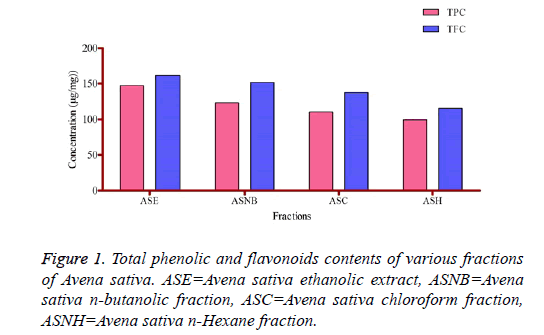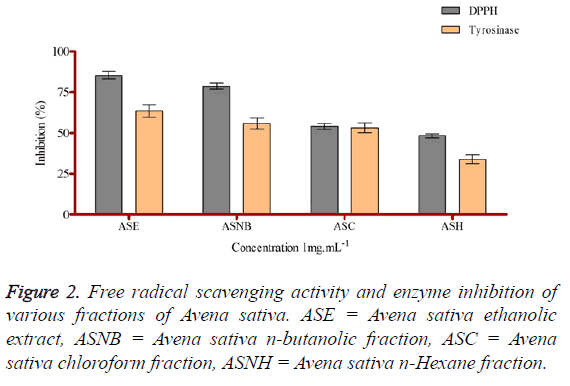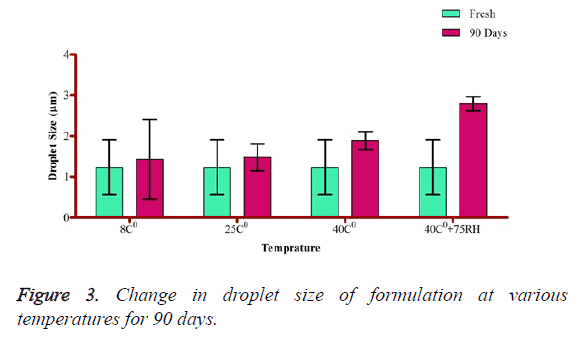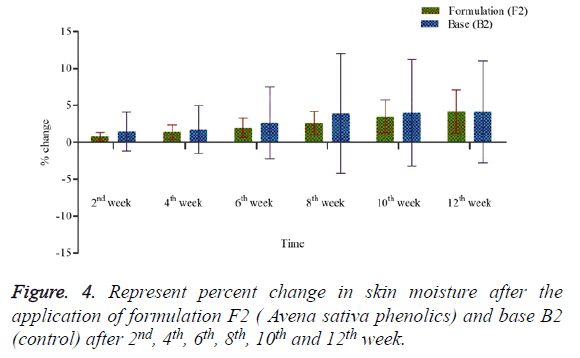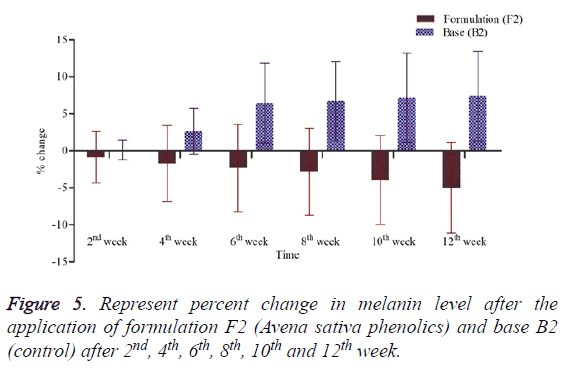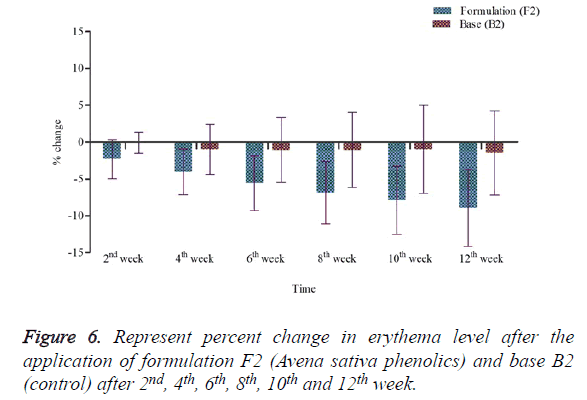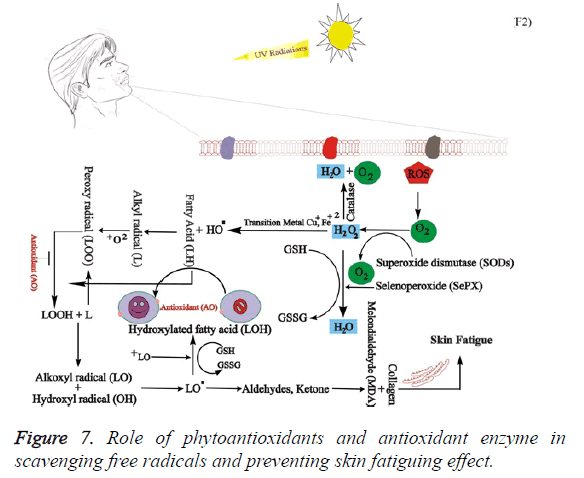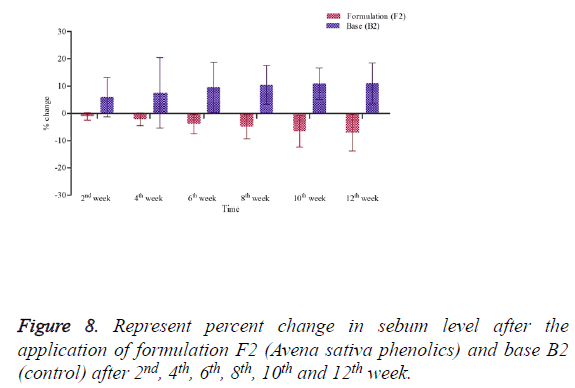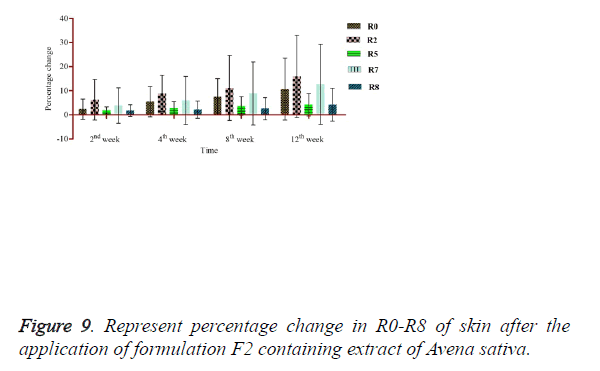ISSN: 0970-938X (Print) | 0976-1683 (Electronic)
Biomedical Research
An International Journal of Medical Sciences
Research Article - Biomedical Research (2019) Volume 30, Issue 3
Phytochemical profiling of Avena sativa for phytoantioxidants compounds with their multidirectional non-invasive investigation for anti-pigmenting and facial skin fatiguing effect with a stable emulgel formulation.
Asrar Muhammad1*, Naveed Akhtar1, Abdul Hameed1,2
1Faculty of Pharmacy and alternative medicine, The Islamia University of Bahawalpur, Pakistan
2School of Pharmacy and Pharmaceutical Sciences, Trinity College, University Of Dublin, Ireland
- *Corresponding Author:
- Asrar Muhammad
Department of Pharmacy and Alternative
Medicine Islamia University of Bahawalpur
Pakistan
Accepted Date: April 26, 2019
DOI: 10.35841/biomedicalresearch.30-19-190
Visit for more related articles at Biomedical ResearchObjective: The current research work was initiated to develop stable Emulgel formulation loaded with natural phenolic compounds from Avena sativa that were extracted with various solvents. Method: The free radical scavenging and tyrosinase inhibition activities were performed in order to observe the effects of phenols and flavonoids in emulgel formulation on healthy human volunteers with non-invasive biophysical methods. Results: The results of the study revealed that ethanolic fraction of Avena sativa accommodate high amount of phenolic acids (147.1135 μg/mg dry powder extract) and flavonoids (161.6374 μg/mg dry powder extract) contents with extraordinary high mushroom tyrosinase (63.651 mg/ml)) inhibition and free radical scavenging (85.39 1mg/mL) potential. The developed formulation loaded with phenolic compounds potentially enhance stratum corneum hydration level, increase collagen synthesis, decrease melanin from melanocytes and oil secretions from sebaceous glands at 0.05 level of significance. Conclusion: The presence of useful phytoantioxidants in Avena sativa results in polishing of mechanical features of skin with reduced levels of roughness, scaliness, smoothness, and wrinkles of photo-aged skin. The investigator attributed that anti-aging activity is related to polyphenols present in extract; as the phenolics have the capability to quench reactive oxygen species.
Keywords
Phytoantioxidants, Melanin, Corneometer, Emulgel.
Introduction
From years, herbs are being used in many areas of medicine especially in most grooming field of cosmetology. These herbal products are free from any harmful effect because of containing natural ingredients that provide different nutrients and minerals to the human body [1]. Now-a-days topical delivery systems are of great significance and attraction as this route of drug administration is apposite for both local as well as systemic delivery of the drug. The direct delivery of the active drugs onto the human skin is not only an effective treatment method itself but also considered as a better remedy for local skin ailments [2]. Topical application has the advantage of no first pass metabolism, so increased availability of drugs at the site of action. In a topical delivery system, the drug moieties diffuse from the delivery system and well absorbed by the skin [3].
Seeds of Avena sativa of Poaceae family were used in this study which is commonly known as oat and its cultivation is done for its edible grains; the oat plant consists of leaves and a shortened stem, giving a rosette type of plant. It is lengthened spindle shaped, up to about 0.5 in. in length and 0.125 in. or less in width [4].
A large number of important constituents or phytochemicals have been reported in such plant including proteins, variety of avenanthramides, carbohydrates, different flavonoids, lipids, saponins, sterols, alkaloids, different kinds of vitamins ( B6 and B12), vitamin A and tocols [5]. It is worth mentioning that a variety of 28 flavonoids been exposed in its seeds and other green parts [6]. In humans and animals compounds like vitamin E and phenolics both are renowned for its have antioxidant properties. The multifunctional characteristics and nutritional profile give uniqueness to Oat. The importance of oat’s different components were also observed in recent developments in food and nutrition [7]. Other important phytochemicals in Avena sativa are p-hydroxybenzoic acid, vanillic acid, avenanthramide (A,K,C),caffiec acid and vanillin [8]. Others are syringic acid, p-coumaric acid, protocatechuric acid, gallic acid and ferulic acid [9]. These important phytochemicals elaborate the medicinal importance of oat. As this plant has a valuable antioxidant property, so it is important to expose its cosmetic benefits.
The current research work was initiated to develop the stable cosmaceutical emulgel formulation loaded with these important phenolic compounds that is novel and to explore their beneficial effects on human facial skin using non-invasive probes. Seeds of Avena sativa of Poaceae family were used in this study which is commonly known as oat and its cultivation is done for its edible grains; the oat plant consists of leaves and a shortened stem, giving a rosette type of plant. It is lengthened spindle shaped, up to about 0.5 in. in length and 0.125 in or less in width [4].
Materials and Methods
Chemicals and equipments
Plant samples (Local Market Bahawalpur, Pakistan), Distilled water (Pharmaceutical Laboratory, The Islamia University of Bahawalpur), Ethanol, n-hexane, Chloroform, n-Butanol, Liquid paraffin, Triethanolamine, and Propylene glycol were purchased from Merck, Darmstadt, Germany. Carbopol 940, Span 20, Tween 20, DPPH, L-DOPA, Mushroom Tyrosinase, Kojic acid, Ascorbic acid (Sigma, USA), Rotary evaporator (Heidolph, Co. Ltd., Japan), UV spectrophotometer (UV 4000 ORI, Germany), microplate reader Synergy HT (BioTek Instrument, USA), Refrigerator (Dawlance, Pakistan), Homogenizer (Germany), Hot Incubator (Sanyo MIR-162, Japan), Digital Humidity Meter (TES Electronic Corp, Taiwan), pH meter (WTW pH-197i, Germany), optical microscope (Eclipse E200, Nikon, Japan), Mexameter®, Corneometer®, Sebumeter® and Elastometer® (Courage +Khazaka Electronic GmbH, Germany).
Plant sample collection and extraction
The seed of Avena sativa was purchased from the local market of Bahawalpur and identified from herbarium department of Botany, The faculty of life science, The Islamia University of Bahawalpur, voucher no: 7563/LS. Dried powder of Avena sativa seeds was accurately weighed to 250 g and then transferred to a container having 1500 mL of a solvent mixture of ethanol: water (70: 30) and methanol: water (80: 20) respectively and then homogenized with a motor driven stirrer. The homogenized mixture was extracted for a time period of 72 hours under dark storage condition at normal room temperature. Then the resultant extract was then passed through multiple layers of muslin (cloth) for normal coarse kind of filtration. The filtered extract was again passed through Whattman No. 1 of filter paper to collect pure and dirt free extract and further evaporated to achieve a concentrated form of the extract by using a rotary apparatus. At the end, the conventional fractionation of extract was done by using a series of variable organic solvents in increasing polarity order. The samples collected after fractionation was completed were designated as ASE (Avena sativa ethanol extract), ASH (Avena sativa n-hexane fraction), ASC (Avena sativa chloroform fraction) and ASNB (Avena sativa n-butanol fraction).
Phytochemical Analysis
Qualitative analysis
For the detection and confirmation of important of phytochemical like polyphenols species, saponin and coumarin compound applied a typical method and for the detection of the rest of many flavonoids and terpenoid species, tannins, and alkaloids moieties w different procedures were used [10].
Determination of total phenolic contents and total flavonoids contents
The quantity of total flavonoid contents (TFC) in plant fractions of Avena sativa was calculated through mixing of contents in each sample portion obtained in at end of fractionation in volume of (0.3 mL) with a measured volume (0.1 mL ) of ( AlCl3 × 6H2O) of solution in ( 0.3 mol L–1) concentration, the reaction is followed by further addition of measured volume of ( 0.15 mL) of sodium nitrite solution in (0.5 mol L–1 ). At the end of 3.4 mL of the volume of methanol (30%) is added [11]. By using spectrophotometer the resultant change in absorbance of the above mixture was seen at 506 nm. TFC are usually expressed in μg quercetin equivalents (QE) mg–1 of dry extract of the plant whereas the quantity of phenolic contents (TPC) in the plant fraction were calculated through the procedure of adding or mixing of a measured volume of 1 mL of the Folin-Ciocalteu reagent to already a prepared mixture of 1 mg of each sample plus the measured volume of 9 mL water and mixed it thoroughly for 5 min. In the second step volume of 10 mL of (Na2CO3) solution in 7% concentration was added. At the end, sufficient volume of water is added to make a final volume of 25 mL of the mixture. The resultant mixture is then incubated for 90 min at 25 c and at end, absorbance was done at 750 nm. TPC are expressed as μg of gallic acid equivalents (GAE) per mg of dry extract of the plant [12].
Free radical scavenging activity
A very useful tool or technique to calculate the antioxidant activity of the different fractions of Avena sativa is 2, 2- diphenyl-1-picryl-hydrazyl (DPPH) method. In this method, a stock solution of DPPH reagent was prepared initially by carefully weighing and dissolving 24 mg of this reagent in a suitable container having the measured volume of 100 mL of methanol and the mixture was stored at 20°C temperature. Then for the calculation of scavenging activity, approximately 3 mL of DPPH reagent from the stock solution was mixed with a measured volume of samples 1 mg mL–1 in different test tubes and after the contents are mixed thoroughly, then incubated them for 15 min at room temperature. Then the absorbance of the mixture was taken at a wavelength of 517 nm. The decrease of absorbance shows the increase of antioxidant activity. In this method, standard reagent we used is pure ascorbic acid [13].
Mushroom tyrosinase enzyme inhibition activity
For the measurement of Tyrosinase inhibition, a procedure is adopted in which (100 ul) of total volume of a mixture of all reagents is used, which was attained by mixing a measured volume of 10 μl of 0.5 mM of test moieties with a volume of 40 μl of 100 mM phosphate buffer with pH range of 6.8 with 20 μl volume of our active enzyme (1000 units). After (mixing and incubating for 5 at 37°C), then added 30 mL measured volume 10 μl of the solution of levo-dopamine in 10 mM concentration which is used as substrate for the enzyme. When the contents are mixed thoroughly incubated the resultant mixture, for 10 min time at room temperature. At the end measured the absorbance at 492 nm using a 96-microplate reader at 490 nm [14].
Development of emulgel
After complete phytochemical profiling, standardization and measurement of antioxidant potentials of different fractions of plants the emulgel formulation was developed using carbopol 940 (2% W/W) (Table 1). For the preparation of O/W emulsion, ingredients of oil and water phase were weighed accurately and then both of these phases were heated separately at water bath up to 75°C. Then these phases were mixed properly with a homogenizer. The speed of homogenizer plays a vital role in development of stable system. Speed of stirrer was initially (2000 rpm for 15min) then (1000 rpm for 5 min) and finally (500 rpm for 5 min) to form a stable o/w emulsion. In the 2nd step of formulation development, gelling agent (Carbopol 940) was dispersed in a measured volume of water of in 2% (w/w) fixed concentration with a mechanical stirrer (1000 rpm speed). Absence of lumps indicates a good quality gel. To maintain pH in a range of 5.5 to 6.5, triethanolamine was added drop wise. Finally, the gradual introduction of o/w emulsion to the already prepared gel with a mechanical stirrer to form an emulgel [15]. For both base (Control) and test emulgel formulation similar technique or methodology was adjusted.
| Ingredients | Control C | Emulsion Containing Oat Extract |
|---|---|---|
| Oily phase | ||
| Liquid paraffin | 7.5%(W/W) | 7.5%(W/W) |
| Span 80 | 1%(W/W) | 1%(W/W) |
| Aqueous phase | ||
| Tween 20 | 0.5%(W/W) | 0.5%(W/W) |
| Propylene glycol | 5%(W/W) | 5%(W/W) |
| propyl paraben | 0.5%(W/W) | 0.5%(W/W) |
| Fruit extract | No extract | 4% |
| Distilled water | Q.S to make 100%(W/W) | Q.S to make 100%(W/W) |
| Carbopol 940 | 2% (W/W) | 2% (W/W) |
Table 1. Composition of active and control Emulgel formulations (100g w/w).
Microscopic analysis and determination of globule size
Droplet size examination of active emulgels was done by operating an optical microscope fitted with a camera. After dilution the minute quantity of emulgel with water (continuous phase) on separate glass slides with an outer coverslip and calculated the size with oil emersion lens (100×/1.25×). Measurements of droplets size were made at zero time and after 90 days. For the random droplet size calculation, we used the software of Digimizer image analyzer.
Rheological aspects
For evaluation and assessment of different viscosity parameters under the influence of shear stress and shear rates and to monitor physical stability of emulgels through these variable parameter, a Brookfield Rheometer with spindle CP41, (model DV-111) was used which is externally connected to software Version V2.6 of Rheocalc [16]. Then various parameters were measured at room temperature (25°C ± 0.5°C) at a speed of 20 to 100 rpm by loading emulgel quantity of approximately 0.5 ± 0.1 g into the assembly of Rheometer. The rheological analyses were done after 24 hours of formulation development and then after 28 days, 60 days and 90 days’ time interval in triplicate manners stored at different conditions. For mathematical calculation and evaluation of given results of rheological parameter like consistency and flow index we employed the Power law as described under:
Ethical consideration
For any of the research work on humans, it is compulsory to acquire permission from the institutional board. So the right procedure was adopted for the grant of approval through the Board of the Advanced Study and Research (BASAR), The Islamia University of Bahawalpur, Pakistan vide letter no. (No. 974/ AS&RB). The research was carried out in accordance with the plans provided in Good clinical practice and through the declaration of Helsinki. Complete protocols of my work conversed with all volunteers and consent was got in written form with right of discontinuing research for any reason. The volunteer has also conveyed all possible adverse effects.
Study design
Total thirteen (13) healthier human male volunteers with different age group (20-25y) were enlisted for this study to measure the skin benefits of emulgel loaded with polyphenols from Avena sativa. It was understood that none of them have marked skin infirmity or ailments as confirmed by Dermatologist. All the volunteers duly signed the terms stated there in the protocol; their consent was acquired in written form. All measures of single blinded research were fulfilled for the comparative study of both placebo and active emulgels formulations under the controlled condition of temperature and humidity (25°C and 40% H) for 12 weeks. Then each of the volunteer was given (50g) of both active emulgel (with extract) and base (without extract) labeled with “right” and “left” on the cover of each container for further usage on respective cheeks. Every individual was informed to endorse full compliance and appear on 2nd, 4th, 6th, 8th, 10th and 12th week for the further evaluation of skin parameters.
A patch test (Analysis for primary skin irritation)
At very start of in-vivo study patch test was done. During this test (5cm × 4cm) space was labeled on fore-arms of the entire participated 63 individual. One gram of each active emulgel and base (without extract) was applied on the respective “right” and “left” arms of all 13 participants of each group (1, 2 or 3) respectively and then hid them with bandage for 48 hour. After getting rid of the patch, skin was estimated through mexameter for any type of skin irritation or erythema.
Facial skin moisture level by Corneometer® CM825
The stratum corneum is considered as the most prominent barrier of human skin. The whole structure and functions of corneum is based on hydration/water level of the skin. The corneometer device is dependent on variances in capacitance value or related to dielectric constant of media employed (water). This device indicates minor fluctuations in capacitance as a result of discrepancies in the hydration level of the skin. The metallic tracks are encircled with glass in the head to impede the passage of electricity. During our study minute discrepancies of di-electric constant are distinguished by the use of device probe that penetrates into the skin. There are two distinguishable tracks as (i) spare of electrons (ii) without electrons. Due to these differences, the electric field is settled with alternating level of attraction and differences in capacitances are noted. It is a very sensitive instrument whose sensitivity is more at a low level of hydration rather than high level [17].
Skin melanin and erythema evaluation by Mexameter® MX18
The melanin is the pigment that imparts color to human skin and erythema is the redness of the skin due to high hemoglobin level. The unusual discrepancies in the color due to these pigments are measured with the help of Mexameter device that an important tool of cosmetic laboratory (Courage+Khazaka, Germany). This device is susceptible to minor discrepancies in skin pigments. Device working is totally based on the absorption of light principle. It emits radiations of different kinds of wavelengths from its operational probe. The extent of light bounced back from the skin is measured by the receiver fitted there. The differences in light can be estimated for the amount of light absorbed. However, the probe and receiver must be at the right place for respective emission and collection of radiations. Both melanin and erythema contents are calculated through the same probe by use of radiations of two distinct wavelengths to differentiate different rates of absorption. In case of melanin, they are engaged to guess absorption rates of melanin pigments and whereas for the case of erythema one of wavelength is for the absorption of (Hb) while other is to devoid of other influential in absorption. The results may vary from zero to 999 in an index. The gradual decrease in extent of pigments or any other discrepancies of skin such as irritation and soothing effects of number of skin care products can also be estimated [17].
Facial skin oil analysis by Sebumeter® MS 815
Sebum is a complex lipid embedded secretion that imparts oiliness to the human body and skin and measured through the use of a device called sebumeter. The working of sebumeter is built on accumulation of sebum on consumed tape via photometric modes [17] of 0.1 mm thickness and furnished with two distinct sections for measurement. A side trigger is there for each turn of the new section. Each new cassette has capacity for 450 trials. When one tape is disbursed, replace it with another one for the hygienic problem. Every defined measuring section has a fixed mirror beneath it and interconnected with the cassette. It is well understood that tape is compelled on measuring area by the mirror. The reading time is 30 seconds. For the reading purpose, head of the cassette is introduced into a device aperture that calculates transparency. The extent of light or radiation transmitted through denotes the sebum content in values from 0-350.
Cutometer® dual MPA 580
Skin elasticity is a key parameter that is very crucial for healthier skin and assessed through a device known as cutometer. The working of this instrument is based on the mechanism of suction of skin. During this method, negative pressure is created in probe of the instrument employed which can pull the skin through probe employed with that pressure and then release it after a while. At the end penetration depth for each skin, the layer is measured through that optical measuring system. This optical structure is composed of two definite prisms and source of light and at the end, a receptor is placed to measure the light. The intensity of light has a strong relation with penetration (mm/time) depth of the skin layer. The resistance or firmness tendered by the skin layer and its ability to return so called elasticity are demonstrated as curves. This device gives us valuable info of mechanical strength of skin and its elastic behavior [17]. Following parameters are studied:
1. R parameters
2. Q parameters
3. F parameters
Facial Skin study was done before and after application of formulation and base can be estimated on week 2nd, 4th, 6th, 8th, 10th and 12th with a Corneometer.
Statistical analysis
The data were analyzed by two way analysis of variance (ANOVA). The Paired sample “t” test was used for multiple comparisons. A p-value ?0.05 considered to be statically significant (SPSS software). GraphPad Prism used for analysis and graphical representation.
Results
Phytochemical grouping
Qualitative analysis of Avena sativa was shown in (Table 2). This was observed that phenols and flavonoids were abundant in ethanol and n-butanol fraction.
| Major Phylogroups | ASE | ASNB | ASC | ASH |
|---|---|---|---|---|
| Phenols | +++ | +++ | ++ | - |
| Flavonoids | ++ | +++ | ++ | - |
| Saponin | - | + | + | - |
| Tanins | - | ++ | + | - |
| Alkaloids | ++ | + | + | - |
ASE=Avena sativa ethanolic extract, ASNB=Avena sativa n-butanolic fraction, ASC=Avena sativa chloroform fraction, ASNH=Avena sativa n-Hexane fraction, +++=high quantity, ++=moderate quantity, +=minute quantity, -=abse
Table 2. Qualitative analysis of Avena sativa.
Saponin was only present in n-butanol and chloroform fraction while absent in n-hexane and ethanol fraction.
In the case of alkaloids, their major quantity was present in ethanol fraction while no sign was observed in n-hexane fraction.
Total phenolic and flavonoids contents
The TPC and TFC in various fractions of Avena sativa was shown in (Table 3) and this was observed that Avena sativa ethanol fraction accommodate the maximum quantity of TPC and TFC while the low quantity of total phenolics was observed in n-hexane fraction of Avena sativa (Figure 1).
| Time | Type | Fresh | 7th Day | 30th Day |
|---|---|---|---|---|
| Color | A | w | w | w |
| B | w | w | w | |
| C | w | w | w | |
| D | W | w | w | |
| Smell | A | -ve | -ve | -ve |
W=white, -ve=no change, ++Ve = medium change, A=8 ºC , B=25 ºC, C=40 ºC, D=40 ºC+75% RH.
Table 3. Physical characteristics of Avena sativa Emulgel formulation kept at 8ºC, 25ºC, 40°C and 40°C+75% RH.
Free radical and enzyme inhibition potential
Ethanol fraction of Avena sativa inhibits a maximum number of oxygen reactive species i.e., 85.39% at 1 mg/mL by DPPH method as shown in (Figure 2). The decreasing order of maximum inhibition of free radicals of various fractions was ASE>ASNB>ASC>ASNH.
Due to high phenolic and DPPH potentials, ethanol fraction also shows maximum tyrosinase enzyme inhibition (Table 3) however n-hexane fraction of Avena sativa show very low enzyme inhibition as compared to other reported fractions.
Physical stability of formulation containing extract of Avena sativa
The color change, smell, and liquefaction in Emulgel formulations containing Avena sativa ethanolic extract and base was studied at different storage conditions as shown in (Table 3).
Droplet analysis of formulations by microscopy
Droplet size analysis was performed and this was observed that globules size increased at higher temperatures. While at 25°C and 8°C little effect was observed as shown in Figure 3.
Rheological behavior of emulgel formulation
The rheological study of formulation was performed at various thermal conditions with respect to tine. The flow index, consistency index and confidence of fit were calculated as shown in (Table 4). The value of thixotropy was calculated and this was observed that all formulations have optimum thixotropic value (Figure 4).
| Consistency Index | ||||
|---|---|---|---|---|
| Days | 8 °C | 25 °C | 40 °C | 40 °C ± 75% RH |
| Fresh | 2432 | 2432 | 2432 | 2432 |
| 30 Days | 2331 | 2329 | 2395 | 2178 |
| 60 Days | 2178 | 1902 | 1992 | 1807 |
| 90 Days | 1902 | 1804 | 1557 | 1366 |
Table 4. Flow index and consistency index of formulation containing ethanolic extract of Avena sativa.
Evaluation of various facial skin indexes after the application emulgel loaded with phenolics
Melanin and Erythema Index: Melanin and erythema level of facial skin was gradually decreased with the application of formulation loaded with phenolics on the right cheek of volunteers (Figure 5 and 6) respectively. While control due to the presence of paraffin oil enhance the melanin level and give skin a greasy look with an increased quantity of facial pores. By applying ANOVA at p<0.05 level of significance it was confirmed that formulation significantly deceased melanin and erythema level with respect to time (Figure 7).
Facial skin oil index: Facial skin oils were decreased by continually applying phenolics formulation of Avena sativa on the right cheek of volunteers for a period of three months (Figure 8). This was observed that control enhance the skin oil level after evaluating mathematically. However statistically by applying ANOVA, it was confirmed that formulation at p<0.05 level of significance, potentially deceased skin sebum level with respect to time.
Effect of formulation on R (R0-R8) parameters of facial skin: The thickness and qualitative properties of the epidermis, dermis, and subcutis affect the mechanical properties of facial skin. Qualitative and quantitative changes occur during aging in the skin, common features of aged skin are; loss of elasticity, reduction in the epidermal thickness and collagen content, enhance wrinkling and pigment lesions. These features vary from person to person; thus, there are individual differences in the degree of skin aging. The cutometers is a non-invasive measurement device that can determine the viscoelastic properties of human skin using the suction method. The parameters of the cutometer correlate with skin induration and dermal edema, and it has been used for studies on normal skin and the diseases that affect the mechanical properties of facial skin [18]. Viscoelastic properties of the facial skin have been evaluated using several mechanical devices like Cutometer, Dermaflex, and Dermal Torque Meter. The research was done and various R parameters i.e., R0, R2, R5, R7, and R8 was evaluated using cutometer after the application of formulation containing extract of Avana sativa (Figure 9).
Discussion
Antioxidants are famous as they neutralize toxic effects generated by free radicals from different sources that may cause damage to the normal skin cells, ultimately protect the skin, therefore they are considered as an imperative anti-aging tactics. The components of our skin involved in this antioxidant system are oxidized and inactive. Flavonoids which are the important polyphenolic moieties are found in plant kingdom possess strong scavenging activities [19]. These compounds are found to be more effective in neurodegenerative ailments, various skin cancers, and cardiac diseases, beneficial effects of flavonoids are reported. The existing mechanism behind these flavonoids is iron chelating process and it also deals with proteins phosphorylation [20]. Our findings show the presence of phenols and flavonoids in ethanol fractions of Avena sativa. A number of polyphenols obtained from tea may be utilized as antioxidants have a distinct anti-aging role. After the topical appliances of green tea extract preparations may be helpful in the maintenance of glutathione and glutathione enzymes level in UV exposed skin and also reduce the oxidative stress [21]. Ethanolic fraction shows maximum free radical scavenging potential with high tyrosinase enzyme inhibition due to the presence of a greater quantity of phenolic and flavonoids [22]. Most of the scientist reported that the phytoantioxidant activity was due to the presence of phenolic compounds [23]. The emulgel formulation loaded with natural phenolics significantly at p<0.05 enhances stratum corneum hydration level with respect to time. The phytoantioxidant like phenols protect skin from oxidative stress mediated by harmful UV radiations and help in regeneration and maintaining hydration level of stratum corneum [24]. A series of oxidative reactions and tyrosinase enzyme involved in the accumulation of melanin in melanocytes [25]. Our study shows that the active formulation containing phenolic rich fraction was potentially inhibited facial skin melanin level by down regulating the activity of α- reductase.
Conclusion
UV radiations constant skin exposure leads to various dermatological problems with several pathobiological alterations in skin cells. The photoprotection is the main approach for managing and protecting healthy skin cells but cosmeceuticals could also be used as an alternative therapy. The selection of therapeutic approaches depends on the nature of these injurious molecular changes. The anti-aging effects of a large number of botanical extract loaded creams have been assessed. The observed antiaging effects of cream formulations could be an outcome of a coordinating action of multiple constituents. Of numerous botanicals, the phenolic acids and flavonoids appear effective against UV radiation-induced damage; however, the evidence-based studies for their antiaging effects are still needed. Since the environment affects the skin-cream interaction, the cautious assessment of their clinical efficacy should be conducted in the future.
Conflict of Interest
The author declares no conflict of interest.
Acknowledgement
The author is thankful to Dean Faculty of Pharmacy and Alternative, The Islamia University of Bahawalpur, Punjab, Pakistan for his kind support and gaudiness. The author is also thankful to Dr. Abdul Hameed Trinity College, University of Dublin Ireland, for his kind support.
References
- Gediya SK, Mistry RB, Patel UK, Blessy M, Jain NH. Herbal Plants: Used as a cosmetics. J Nat Prod Plant Resour 2011; 1:24-32.
- Mitkari B, Korde S, Mahadik K, Kokare CR. Formulation and evaluation of topical liposomal gel for fluconazole. Indian J Pharm Educ Res 2010; 44:324-33.
- Zi P, Yang X, Kuang H, Yang L, Yu L. Effect of HPβCD on solubility and transdermal delivery of capsaicin through rat skin. Int J Pharm 2008; 358:151-158.
- Janatuinen E, Kemppainen T, Pikkarainen P, Holm KH, Kosma VM, Uusitupa MI, Mäki M, Julkunen RJ. Lack of cellular and humoral immunological responses to oats in adults with coeliac disease. Gut 2000; 46:327-331.
- Singh R, De S, Belkheir A. Avena sativa (Oat), a potential neutraceutical and therapeutic agent: an overview. Crit Rev Food Sci Nutr 2013; 53:126-144.
- Duke J. Handbook of phytochemical constituents of GRAS herbs and other economic plants. Handbook of phytochemical constituents of GRAS herbs and other economic plants 1992.
- Butt MS, Tahir NM, Khan MKI, Shabir R. Oat: unique among the cereals. Eur J Nutr 2008; 47:68-79.
- Emmons CL, Peterson DM, Paul GL. Antioxidant capacity of oat (Avena sativa L.) extracts. 2. In vitro antioxidant activity and contents of phenolic and tocol antioxidants. J Agric Food Chem 1999;47: 4894-4898.
- Peterson DM. Oat antioxidants. J Cereal Sci 2001; 33:115-129.
- Ramu G, Mohan GK, Jayaveera K, Dhanapald SP, Senthilkumar G. Preliminary phytochemical and antioxidant study of hydroalcoholic extracts from selected genera of Indian Lamiaceae. Asian Pac J Trop Biomed 2012; 2:S685-688.
- Park YS, Jung ST, Kang SG Heo GB, Avila PA, Toledo F, Drzewiecki J, Namiesnik J, Gorinstein S. Antioxidants and proteins in ethylene-treated kiwifruits. Food Chem 2008; 107:640-648.
- Kim DO, Chun OK, Kim YJ, Moon HY, Lee CY. Quantification of polyphenolics and their antioxidant capacity in fresh plums. J Agric Food Chem 2003;51:6509-6515.
- Majid M, Khan MR, Shah NA, Ul Haq, Farooq MA, Ullah S, Sharif A, Zahra Z, Younis T, Sajid M.. Studies on phytochemical, antioxidant, anti-inflammatory and analgesic activities of Euphorbia dracunculoides. BMC Complement Altern Med 2015; 15:349.
- Kim YJ. Antimelanogenic and antioxidant properties of gallic acid. Biol Pharm Bull 2007;30:1052-55.
- Khullar R, Kumar D, Seth N, Saini S. Formulation and evaluation of mefenamic acid emulgel for topical delivery. Saudi Pharm J 2012; 20:63-67.
- Gaspar L, Campos PM. Rheological behavior and the SPF of sunscreens. Int J Pharm 2003; 250:35-44.
- Courage K, Khazaka G. Information and operating instructions for the multi probe adapter MPA and its probes. 2004.
- Ryu HS, Joo YH, Kim SO, Park KC, Youn SW. Influence of age and regional differences on skin elasticity as measured by the Cutometer®. Skin Res Technol 2008; 14:354-358.
- Afaq F, Mukhtar H. Photochemoprevention by botanical antioxidants. Skin Pharmacol Physiol 2002; 15:297-306.
- Clark RE, Broadbent NJ, Squire LR. Impaired remote spatial memory after hippocampal lesions despite extensive training beginning early in life. Hippocampus 2005; 15:340-346.
- Vayalil PK, Elmets CA, Katiyar SK. Treatment of green tea polyphenols in hydrophilic cream prevents UVB-induced oxidation of lipids and proteins, depletion of antioxidant enzymes and phosphorylation of MAPK proteins in SKH-1 hairless mouse skin. Carcinogenesis 2003; 24:927-936.
- Passi S, Porro NM. Molecular basis of substrate and inhibitory specificity of tyrosinase: phenolic compounds. Br J Dermatol 1981; 104:659-65.
- Kaur CD, Saraf S. Development of photoprotective creams with antioxidant polyphenolic herbal extracts. Res J Med Plant 2012; 6:83-91.
- Jadoon S, Karim S, Asad MHHB, Akram MR, Khan AK, Malik A, Chen C, Murtaza G. Anti-aging potential of phytoextract loaded-pharmaceutical creams for human skin cell longetivity. Oxid Med Cell Longev 2015.
- Boelsma E, Hendriks HF, Roza L. Nutritional skin care: health effects of micronutrients and fatty acids. Am J Clin Nutr 2001; 73:853-864.
